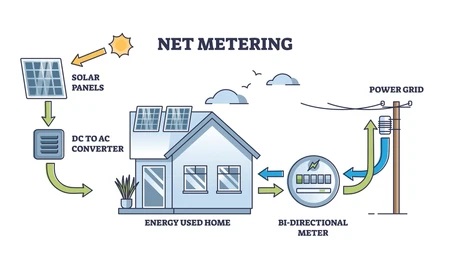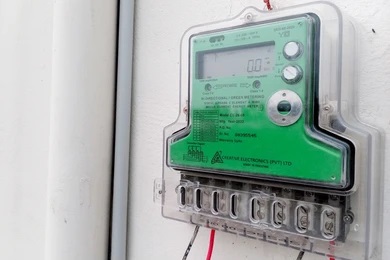What is Virtual Net Metering? A Simple Guide
Virtual Net Metering (VNM) is a term you may have come across if you’re exploring solar power options, especially for shared or multi-unit buildings. But what does it really mean? This guide breaks it down so you can understand how VNM works and why it’s beneficial, especially for apartment dwellers, offices, and shared communities looking to harness the power of the sun.
Understanding Net Metering
Before diving into Virtual Net Metering, let’s touch on regular net metering. In simple terms, net metering is a system that lets you earn credits on your energy bill by sending any extra electricity your solar panels generate back to the grid. So, if you produce more electricity than you use, your meter runs “backwards,” reducing your bill.
So, What is Virtual Net Metering?
Virtual Net Metering takes this idea one step further, allowing multiple users to share the benefits of a single solar system. It’s like having a virtual share in a solar project. Instead of needing individual solar panels on each property, people can use power from a central solar system, often located nearby. This setup is particularly helpful for those in shared spaces, like apartment complexes, office buildings, or communities with common energy needs.
With VNM, each participant’s share of the electricity generated by the shared solar system is credited to their individual utility accounts. You can think of it as owning a “slice” of the solar system, where each participant gets a credit for their portion of the energy.
How Does Virtual Net Metering Work?
Here’s how the process works in simple steps:
- Solar System Installation: A solar power system is installed at a shared location, like on a building rooftop or a community area.
- Electricity Generation: The solar panels generate electricity, which is fed into the grid.
- Credit Allocation: The utility company tracks how much electricity the solar system generates and allocates credits to the accounts of each participating user based on their agreed-upon share.
- Bill Reduction: Each participant’s bill is reduced based on the amount of electricity credited to them from the shared system.
Who Can Benefit from Virtual Net-Metering?
Virtual Net Metering is ideal for:
- Apartment Residents: For people living in apartments or condos who can’t install their own solar panels, VNM offers a chance to enjoy solar savings.
- Businesses in Shared Buildings: Offices or businesses in shared buildings can reduce their energy costs by joining a VNM system.
- Communities and HOAs: Homeowners’ associations and neighborhoods that want to invest in community solar projects can make use of VNM to share the benefits among members.
- Nonprofit Organizations: Schools, community centers, and other nonprofits can benefit from VNM by sharing a central solar system, making solar affordable and accessible.
Why is Virtual Net Metering Important?
- Access to Solar Energy: VNM opens the door for those who cannot install solar panels directly, giving them access to clean, renewable energy.
- Cost Savings: By allowing shared use of solar, VNM reduces the costs associated with energy bills, helping participants save over time.
- Encourages Community Solar Projects: With VNM, communities are more likely to invest in shared solar installations, making renewable energy accessible to more people.
- Supports Renewable Goals: VNM helps local and national renewable energy targets by making solar energy more widely available and practical, which supports the shift toward greener energy sources.
Virtual Net Metering vs. Traditional Net Metering

Both systems help you save on energy costs, but the difference is in how they apply to different types of properties. Traditional net metering benefits single homeowners who have their own solar systems, whereas VNM serves people in shared spaces, allowing them to access solar energy without individual installations.
How to Set Up Virtual Net-Metering
Setting up Virtual Net-Metering usually involves:
- Collaborating with a Utility Provider: Not all utility companies offer VNM, so start by checking if your provider supports it.
- Joining a Community Solar Project: Many areas have community solar projects where you can enroll for VNM and receive energy credits on your bill.
- Agreeing on Credit Shares: For businesses or residents in shared buildings, agree on how credits will be allocated to each participant based on their energy needs.
Is Virtual Net-Metering Right for You?
If you live in an apartment, share a building, or are part of a community interested in solar, then VNM could be a good fit. It provides an affordable and simple way to tap into solar energy without the need for a personal solar installation.
Conclusion
Virtual Net-Metering is making solar power more accessible, especially for people in shared spaces. By sharing a single solar system, users can enjoy cost savings, lower bills, and support a greener future. If going solar seems complicated, VNM offers an easy and effective way to join the renewable energy movement.
Also Read:












PM Kusum Yojana
October 26, 2024[…] What is Virtual Net Metering? A Simple Guide […]
PM Kusum Yojana: Bringing Solar Power To Indian Farmers - Vox Solar
December 28, 2024[…] What is Virtual Net Metering? A Simple Guide […]
TOPCon Solar Panels: The Future Of Solar Technology - Vox Solar
December 28, 2024[…] What is Virtual Net Metering? A Simple Guide […]